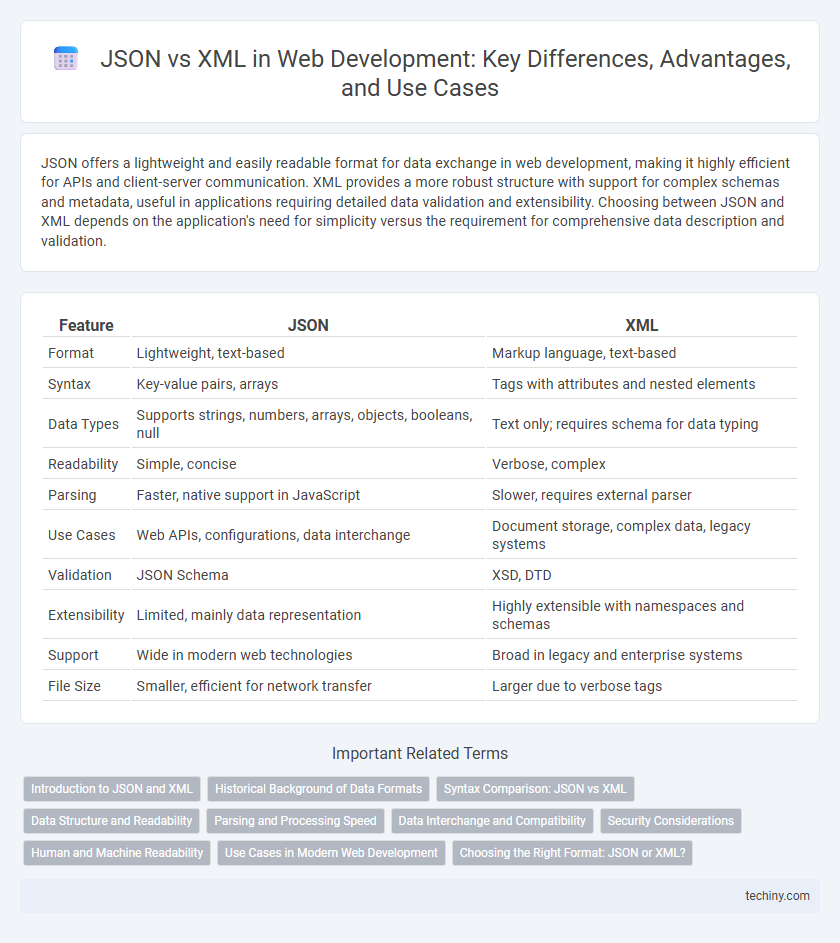JSON offers a lightweight and easily readable format for data exchange in web development, making it highly efficient for APIs and client-server communication. XML provides a more robust structure with support for complex schemas and metadata, useful in applications requiring detailed data validation and extensibility. Choosing between JSON and XML depends on the application's need for simplicity versus the requirement for comprehensive data description and validation.
Table of Comparison
| Feature | JSON | XML |
|---|---|---|
| Format | Lightweight, text-based | Markup language, text-based |
| Syntax | Key-value pairs, arrays | Tags with attributes and nested elements |
| Data Types | Supports strings, numbers, arrays, objects, booleans, null | Text only; requires schema for data typing |
| Readability | Simple, concise | Verbose, complex |
| Parsing | Faster, native support in JavaScript | Slower, requires external parser |
| Use Cases | Web APIs, configurations, data interchange | Document storage, complex data, legacy systems |
| Validation | JSON Schema | XSD, DTD |
| Extensibility | Limited, mainly data representation | Highly extensible with namespaces and schemas |
| Support | Wide in modern web technologies | Broad in legacy and enterprise systems |
| File Size | Smaller, efficient for network transfer | Larger due to verbose tags |
Introduction to JSON and XML
JSON (JavaScript Object Notation) is a lightweight, text-based data interchange format commonly used in web development for its simplicity and easy integration with JavaScript. XML (eXtensible Markup Language) is a flexible, markup language that defines rules for encoding documents in a format readable by both humans and machines. Both JSON and XML are essential for data exchange, with JSON favored for its compact size and ease of parsing, while XML offers robust schema validation and metadata support.
Historical Background of Data Formats
JSON emerged in the early 2000s as a lightweight data interchange format designed for simplicity and ease of use in web applications. XML, developed in the late 1990s, was created as a flexible markup language aimed at encoding documents and data with a focus on extensibility and validation. The rise of JavaScript and the need for efficient data exchange in AJAX-driven sites popularized JSON, while XML's verbose syntax and complex parsing limited its use primarily to legacy systems and enterprise applications.
Syntax Comparison: JSON vs XML
JSON syntax is lightweight and uses key-value pairs enclosed in curly braces, with arrays represented by square brackets, making it easy to read and write for web developers. XML syntax relies on nested tags with explicit opening and closing elements, supporting attributes and complex hierarchical data but resulting in more verbose code. JSON's minimalistic format reduces parsing time and bandwidth usage, whereas XML's rigid structure allows for detailed schema validation and metadata description.
Data Structure and Readability
JSON uses a lightweight data structure based on key-value pairs and arrays, making it easier to read and write compared to XML's verbose tag-based hierarchy. JSON's simple syntax supports native data types like strings, numbers, and booleans, enhancing parsing speed and developer efficiency. XML provides more complex schema validation and metadata capabilities but at the cost of increased readability challenges due to its nested elements and extensive markup.
Parsing and Processing Speed
JSON offers faster parsing and processing compared to XML due to its lightweight structure and native compatibility with JavaScript, making it ideal for web applications. XML parsing requires complex parsers and additional processing overhead with verbose syntax, which slows down execution. Efficient JSON parsing tools significantly reduce data transfer time and improve overall web performance.
Data Interchange and Compatibility
JSON and XML serve as data interchange formats widely used in web development, with JSON favored for its lightweight structure and ease of parsing in JavaScript environments, enhancing compatibility with modern web APIs and front-end frameworks. XML offers extensive support for complex data structures and namespaces, making it suitable for legacy systems and applications requiring strict validation through schemas like XSD. Both formats enable effective data exchange across diverse platforms, but JSON's simplicity and native integration with JavaScript boost performance and reduce overhead in asynchronous web communication.
Security Considerations
JSON offers a more secure data interchange format by reducing the risk of XML-specific vulnerabilities such as XML External Entity (XXE) attacks, which exploit XML parsers to access unauthorized resources. JSON parsers typically process data without executing external entities, minimizing attack surfaces and improving security in web applications. Developers must still validate and sanitize JSON inputs to protect against injection attacks and ensure secure data handling.
Human and Machine Readability
JSON offers superior human readability with its clean, lightweight syntax using key-value pairs and arrays, making it easier for developers to write and debug compared to the verbose and tag-heavy structure of XML. Machines process JSON more efficiently due to its straightforward data interchange format, resulting in faster parsing and reduced computational overhead relative to XML's complex hierarchical elements. These readability advantages contribute to JSON's widespread adoption in modern web development for API communication and data serialization.
Use Cases in Modern Web Development
JSON is preferred in modern web development for APIs and data interchange due to its lightweight nature and seamless integration with JavaScript, making it ideal for client-server communication and real-time web applications. XML remains relevant in scenarios requiring complex document structures, extensive metadata, or strict schema validation, such as enterprise-level configuration files and legacy system integrations. The choice between JSON and XML ultimately depends on the specific use case, with JSON dominating front-end frameworks and RESTful services, while XML persists in SOAP-based services and systems prioritizing robust data validation.
Choosing the Right Format: JSON or XML?
Choosing the right format between JSON and XML depends on project requirements such as data complexity, interoperability, and ease of use. JSON offers lightweight data structures with faster parsing, making it ideal for web APIs and mobile applications. XML supports extensive metadata and schema validation, which is beneficial for enterprise-level integrations and document-oriented data exchange.
JSON vs XML Infographic

 techiny.com
techiny.com